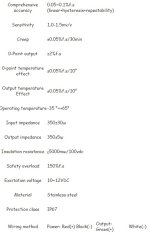Hello,
I'm currently working on a project where I need to read values off my 0-3kg Strain Gauge and display them on my HMI display.
I've connected the SG to a Mitsubishi A/D module per the V1+ input and COM, wrote a test program in GX-W3 and displayed the values to the HMI.
Problem is the values do not make sense. When I display them I get a 10 character number, where the last 8 digits change slightly upon detection of force. It also jumps erraticaly (not at all incrementaly) over the value 0 to -10 digit number, upon the reversal of force on the sensor. How could I fix this?
Other info:
-PLC: FX5UC-32MT/DSS-TS
-A/D: FX5-4AD-ADP
-SG is wired directly to the A/D, no external AMP
-The Strain Gauge was tested on an Oscilloscope prior to being connected to the PLC, and was working fine.
-A/D configured in GX-W3 to -10v - 10v range. I tried using the scale function, but with it turned on, the display did not work at all.
-GT-D3 used for the display, with Signed 32bit display option, reading from D10 register.
-Program and Strain Gauge info in attached pictures.
Thank you for the help


I'm currently working on a project where I need to read values off my 0-3kg Strain Gauge and display them on my HMI display.
I've connected the SG to a Mitsubishi A/D module per the V1+ input and COM, wrote a test program in GX-W3 and displayed the values to the HMI.
Problem is the values do not make sense. When I display them I get a 10 character number, where the last 8 digits change slightly upon detection of force. It also jumps erraticaly (not at all incrementaly) over the value 0 to -10 digit number, upon the reversal of force on the sensor. How could I fix this?
Other info:
-PLC: FX5UC-32MT/DSS-TS
-A/D: FX5-4AD-ADP
-SG is wired directly to the A/D, no external AMP
-The Strain Gauge was tested on an Oscilloscope prior to being connected to the PLC, and was working fine.
-A/D configured in GX-W3 to -10v - 10v range. I tried using the scale function, but with it turned on, the display did not work at all.
-GT-D3 used for the display, with Signed 32bit display option, reading from D10 register.
-Program and Strain Gauge info in attached pictures.
Thank you for the help






